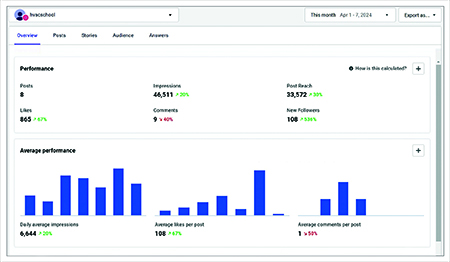Being an HVAC contractor in the digital age means you likely have some online presence. Maybe you have a company website. Or perhaps you dove headfirst into the world of Facebook, Instagram, TikTok, or all the above. In any case, having a digital presence puts your business on customers’ radar when they need an HVAC contractor to repair, upgrade, or replace their system.

Having a strong, deliberate online presence can bring additional sales to your company. However, getting customers to engage with your company online isn’t as simple as creating a social media page or website and writing posts to your heart’s content.
You need to look at numbers and draw conclusions about your marketing strategies to get customers’ attention. It’s a lot like gathering static pressure and airflow readings when diagnosing a problem in the field.
Just as you test and measure in the field and analyze those readings to help inform your diagnostic process, you can look at statistics and analyze them to forge a marketing strategy that brings actual results. That’s called “marketing analytics.”
What is Marketing Analytics?
Broadly speaking, marketing analytics is how we convert measured numbers into insights we can use to make decisions.

social media management software that can provide analytics reports.
It’s a skill HVAC technicians already use in the field. When they go to a customer’s home and measure static pressures, the numbers read on the gauges or apps might not mean much to the average person. But your technicians can tell if the HVAC system has high, low, or normal pressure.
We attach a meaning to those numbers by comparing them to what’s normal, which informs our diagnostic processes.
Let’s say you measure a total external static pressure of 0.9-in. w.c. when the maximum rated pressure drop is 0.5-in. w.c. Your average Joe won’t know what a pressure drop of 0.9-in. w.c. means, but professional HVAC technicians will know that it’s high! The high static pressure will inform the technician’s next move as they attempt to diagnose the problem—and, eventually, fix it.
Like Versus Subscribe
The same principle applies in the digital world. We can see how many people liked our posts or subscribed to a newsletter. Still, those numbers don’t help educate and reach potential customers unless we understand what they mean.
Now, if we notice trends where before-and-after photos get more likes and comments than sales infographics, we’ll know to post more before-and-after photos to interest more customers.
Generally, marketing analytics could be as simple as watching trends in how many likes, comments, clicks, etc. we receive per post on our website or social media outlets.
We’re taking numbers, understanding what sorts of insight they give us about the health of our marketing strategies, and using them to decide future steps. That sounds like what we’d do to diagnose an HVAC system or prepare a duct upgrade, doesn’t it?
Click Below for the Next Page:













Recent Comments